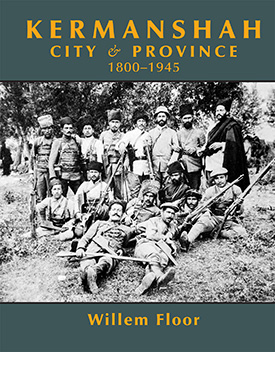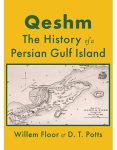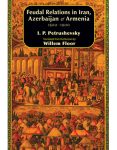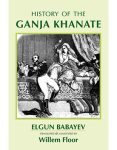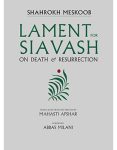About the Book
Kermanshah was one of the most important commercial gateways to Iran and a crucial transit station on the trade route between Iraq and Iran. It was also a gathering point for pilgrims going to and coming back from the holy shrines of Kerbela and Najaf. What’s more, from 1920 to 1925, it was the government’s most important non-oil revenue earner. Despite all this, Kermanshah has been mostly ignored by historians.
In Kermanshah: City and Province, 1800 to 1945, Willem Floor discusses, in detail, the rise of the city as an important bandar, or entrepôt; as well as how tribal politics dominated the city. As a result of which, Kermanshah remained a very conservative city that elected reactionary tribal chiefs and landowners to parliament. Because of its strategic position on the border with Iraq, the province became consequential whenever war broke out with the Ottomans. During World War I, from 1916 to 1917, it became the capital of the short-lived Mohajerin movement (migration of Majles deputies from Tehran) and a battlefield for the combined Ottoman and German forces against the Russians. Although this last event has been studied to a certain extent, this book provides copious new and nuanced information about the period. Finally, the book provides detailed new information about political events from 1906 to 1945 that show how provincial politics had a life of its own. So-called political differences may have been clad in a national and/or constitutionalist guise, but these differences were determined more by local cleavages than national ones. The history of Kermanshah demonstrates that, in the end, “all politics is local.”
Reviews
coming soon
Contents/Excerpt
CONTENTS
- Introduction, Xi;
- Chapter One: Kermanshah before 1800, 1;
- Chapter Two: The City of Kermanshah, 13;
- Chapter Three; Administrative Structures, 131;
- Chapter Four: The Province of Kermanshah, 173;
- Chapter Five: Agriculture, 209;
- Chapter Six: Trade, 225;
- Chapter Seven: Political and Administrative Developments in Kermanshah, 291
APPENDICES
- Appendix I; The Jewish Community Of Kermanshah, 484;
- Appendix Ii; Junkers Air Service, Persia: Flight and Price Schedule, 519;
- Appendix Iii; Notice from the Poor Fund Committee of Kermanshah, 520;
- Appendix Iv; Landowners Reaction to New Wheat Assessment Regulations, 526;
- Appendix V; Petition of Persian Merchants About the Qarasuran, 529; Appendix Vi;
- The Turkish Sanitary Service and The Shiah Pilgrimage, 531; Appendix Vii; List of Governors (1797-1947), 534;
- Appendix Viii; Feelings of Persian Officers ;
- Appendix Ix; Fake Telegram from Mullah Abdullah Mazandrani and Mullah Kazem; Khorassani, 540;
- Appendix X; Elections Kermanshah Style (1947), 542;
- Appendix Xi; Quis Custodiet Custodes?, 544;
- Appendix Xii; Text of Undertaking By Abbas Khan Gubadian ;
- Appendix Xiv; Qasr-e Shirin, 559;
- Bibliography, 560; Index, 577
About the Author
Willem Floor studied development economics and non-western sociology, as well as Persian, Arabic and Islamology from 1963-67 at the University of Utrecht (the Netherlands). He received his doctoral degree from the University of Leiden in 1971. Since 1983, Dr. Floor was employed by the World Bank as an energy specialist, however, after his retirement in 2002, he has dedicated his time to the study of the social and political history of Iran, and has published extensively throughout this time. His books include: Public Health in Qajar Iran, Agriculture in Qajar Iran, and The History of Theater in Iran, as well as, The Persian Gulf: A Political and Economic History of 5 Port Cities, 1500-1730, its second volume, Persian Gulf: The Rise of the Gulf Arabs, 1747-1792, third volume, The Rise and Fall of Bandar-e Lengeh, the fourth volume, Bandar Abbas: The Natural Gateway of Southeast Iran, and the fifth volume, The Persian Gulf: Links with the Hinterland Bushehr, Borazjan, Kazerun, Banu Ka’b, & Bandar Abbas, The Persian Gulf: The Hula Arabs of The Shibkuh Coast of Iran, and The Persian Gulf: Dutch-Omani Relations A Commercial & Political History 1651-1806, and The Persian Gulf: Muscat – City, Society and Trade . He has also published, Travels Through Northern Persia, 1770-1774, Titles and Emoluments in Safavid Iran, and A Social History of Sexual Relations in Iran; Labor and Industry in Iran, 1850-1941; Guilds, Merchants and Ulama in 19th Century Iran; The Rise and Fall of Nader Shah; Games Persians Play, and History of Bread in Iran. His translations include: Samuel Gottlieb Gmelin’s Travels Through Northern Persia 1770–1774 , and with Hasan Javadi, Abbas Qoli Aqa Bakikhanov’s The Heavenly Rose-Garden: A History of Shirvan & Daghestan; Evliya Chelebi’s Travels in Iran and the Caucasus, 1647 and 1654; A Man of Two Worlds: Pedros Bedik in Iran, 1670–1675, Awake: A Moslem Woman’s Rare Memoir of Her Life and Partnership with the Editor of Molla Nasreddin, the Most Influential Satirical Journal of the Caucasus and Iran, 1907–1931, and Engelbert Kaempfer: Exotic Attractions in Persia, 1684–1688: Travels & Observations.
Willem Floor was invited to Tehran in February, 2017 and presented with the Farabi International Prize for Humanitarian Studies.

